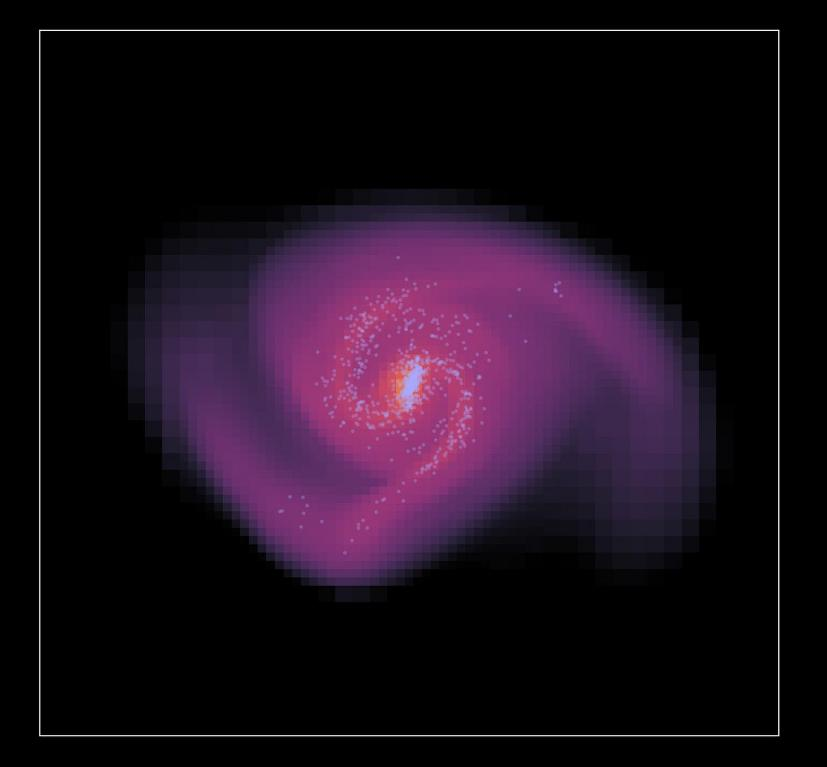Feb 10 2020
For the first time, scientists from the University of Strasbourg and the University of Bonn have replicated the development of galaxies in a universe without any sign of dark matter.
 The distribution of matter 1.5 billion years after the start of the simulation. The lighter the color, the higher the density of the gas. The light blue dots show young stars. Image Credit: © AG Kroupa/Uni Bonn.
The distribution of matter 1.5 billion years after the start of the simulation. The lighter the color, the higher the density of the gas. The light blue dots show young stars. Image Credit: © AG Kroupa/Uni Bonn.
To simulate this process on the computer, the researchers modified Newton’s laws of gravity. The galaxies that were produced in the computer calculations are analogous to those that are actually seen at present.
The researchers claimed that their assumptions might solve a number of mysteries associated with contemporary cosmology. The study results were published in the Astrophysical Journal.
These days, cosmologists believe that after the Big Bang, matter was not distributed completely uniformly. Due to their more powerful gravitational forces, the denser places attracted progressively more matter from their surroundings. Over the duration of many billion years, such gas built up and ultimately created the galaxies that are currently seen by individuals.
The so-called dark matter is a major ingredient of this concept. But this dark matter is believed to play a role in the preliminary random distribution that caused the gas clouds to agglomerate. It even explains some perplexing observations.
For example, in rotating galaxies, stars usually move so quickly that they should, in fact, be ejected. However, another source of gravity seems to be present in the galaxies; this gravity is believed to prevent this—a type of “star putty” that cannot be observed with telescopes: that is, dark matter.
But a direct proof of its existence is yet to become available.
Perhaps the gravitational forces themselves simply behave differently than previously thought.
Dr Pavel Kroupa, Professor, Helmholtz Institute for Radiation and Nuclear Physics, University of Bonn
Dr Kroupa is also associated with the Astronomical Institute of Charles University, Prague.
This concept is termed MOdified Newtonian Dynamics (abbreviated as MOND); it was identified by Professor Dr Mordehai Milgrom, an Israeli physicist.
The theory states that the attraction between a couple of masses follows Newton’s laws of gravity only up to a specific point. Under extremely low accelerations, as is the case in galaxies, it turns out to be significantly stronger. This is the reason why galaxies do not break apart and is attributed to their rotational speed.
Results Close to Reality
In cooperation with Dr. Benoit Famaey in Strasbourg, we have now simulated for the first time whether galaxies would form in a MOND universe and if so, which ones.
Nils Wittenburg, Doctoral Student, Helmholtz Institute for Radiation and Nuclear Physics, University of Bonn
To do this, Wittenburg utilized a computer program to perform intricate gravitational calculations. The software was developed in Kroupa’s team. In the case of MOND, the attraction of a body relies on its own mass and also depends on whether other objects are located nearby.
The researchers subsequently utilized this software to replicate the formation of both galaxies and stars, beginning from a gas cloud that occurred several hundred thousand years following the Big Bang.
“In many aspects, our results are remarkably close to what we actually observe with telescopes,” Kroupa explained. For example, the stars’ velocity and distribution in the galaxies generated by the computer follow the same kind of pattern that can be observed in the night sky.
Furthermore, our simulation resulted mostly in the formation of rotating disk galaxies like the Milky Way and almost all other large galaxies we know. Dark matter simulations, on the other hand, predominantly create galaxies without distinct matter disks - a discrepancy to the observations that is difficult to explain.
Dr Pavel Kroupa, Professor, Helmholtz Institute for Radiation and Nuclear Physics, University of Bonn
Calculations based on the existence of dark matter are also highly responsive to variations in specific parameters, like the frequency of supernovae and their associated impact on the distribution of matter in galaxies. But in the MOND simulation, such factors seldom had a role to play.
However, the newly published results from Strasbourg, Prague, and Bonn do not match with reality in all the points. “Our simulation is only a first step,” Kroupa emphasized.
So far, the researchers have only made very basic assumptions regarding the matter’s original distribution and the situations in the young universe.
“We now have to repeat the calculations and include more complex influencing factors. Then we will see if the MOND theory actually explains reality,” concluded Kroupa.